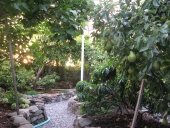




 2
2




 1
1








Check out we're up to:
https://www.facebook.com/OmandsOrganics




Author, The Year-Round Solar Greenhouse




Lindsey Schiller wrote:
Rather than earth tubes, look into an "earth to air heat exchanger" (alternate search names, GAHT system or climate battery) which stores the heat of the greenhouse in the soil underground.




Andrew Parker wrote:
Lindsey Schiller wrote:
Rather than earth tubes, look into an "earth to air heat exchanger" (alternate search names, GAHT system or climate battery) which stores the heat of the greenhouse in the soil underground.
Semantics. They are, essentially, the same thing. You could include in your search the terms: earth battery and low-grade geothermal. YouTube has many sunken/underground/earth sheltered greenhouse ideas, as well as various geothermal/earth battery options.
Compost heat is another good option. I am not sure having it, and animals, in the greenhouse would be good year-round, especially if you get high summer temperatures and/or a lot of sun. You could have it, and animals, in an adjoining structure. Availability of biomass to feed the compost pile may be a limiting factor in some areas. This video was recently posted in the Compost section of Permies.
It is often quicker and, ultimately, cheaper to purchase someone else's expertise, so I am in no way seeking to detract from what Lindsey is offering.
Check out we're up to:
https://www.facebook.com/OmandsOrganics








They are NOT essentially the same thing

|
Seriously Rick? Seriously? You might as well just read this tiny ad:
Support permies and give beautiful gifts to gardeners: permaculture playing cards.
https://gardener-gift.com/
|





